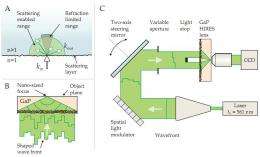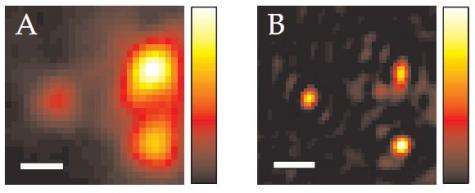March 25, 2011 report
New lens doubles the resolution of conventional microscopes

(PhysOrg.com) -- Conventional lenses can resolve structures around 200 nanometers (nm) in size, but scientists in Europe have for the first time developed a lens capable of achieving optical resolution of under 100 nm at visible wavelengths.
A conventional lens has a diameter and a focal length and the greatest resolution is provided by a lens with the largest diameter and shortest focal length. The physical limitations of lenses means that the real limit of resolution (known as the diffraction limit) is around half the wavelength of the light used to create the image, which for visible light is approximately 200 nm.
The new lens, developed by Dr E.G. van Putten and colleagues in The Netherlands and Italy, works in a different way to a conventional lens and provides greater than twice the resolution. The new lens uses a wafer of gallium phosphide (GaP), which has a large refractive index. One side of the wafer was first dipped in acid to create a light scattering surface, and then a thin layer of silicon was deposited on the other side to absorbs most of the light hitting that side of the wafer.
When light illuminates the GaP side it is scattered in every direction, but some passes through with a distorted wave front. When 561 nm laser light is used the result is a speckled light because some parts are in phase and therefore create bright spots, some parts are out of phase and therefore create dark spots, and other parts of the light are in between, creating dull spots.
The distorted wave front was recorded using a charged coupled device (CCD) chip to allow its shape to be analyzed. This information was then used to program a spatial light modulator to distort the incoming laser light before it hit the lens and cancel out the distortion about to be produced by the light-scattering layer. The spatial modulator also brought the modulated light to a focus on the other side of the wafer.
The researchers etched away a small section of the silicon layer and deposited gold nanoparticles 97 nm in diameter in this non-absorbing area. The wafer was then illuminated by laser light, and the gold particles brought into focus. (Gold was used because it shines brightly when hit by the light, which makes focusing easier.)
The focal point is much tighter than a conventional lens can produce, and this allows it to achieve greater resolution. It can be moved around, which allows the object to be scanned by moving the focus back and forth across it.
The team succeeded in imaging gold nanoparticles at 97 nm resolution, which is around twice the resolution achieved by a conventional microscope, but they say their system should be capable of 72 nm resolution.

There are disadvantages to the new technique, the major one being that at present the sample is directly on the surface of the lens, which would mean it could not be used to image inside living structures such as cells. Another disadvantage is the small (2 μm square) field of view.
The major advantage of the new technique is that the gallium phosphide wafer is cheap and simple to make and the system does not need expensive lenses like those used for structured illumination microscopy (which achieves a resolution of around 100 nm).
More information: Scattering Lens Resolves sub-100 nm Structures with Visible Light, arXiv:1103.3643v1 [physics.optics] arxiv.org/abs/1103.3643v1
© 2010 PhysOrg.com
















